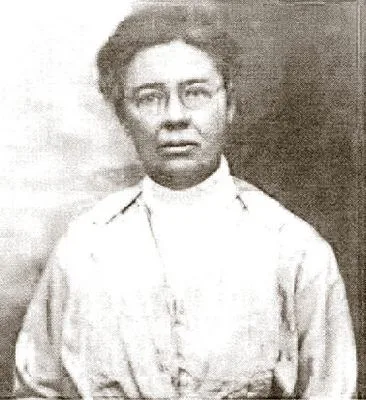In 1917, a frightening encounter with a large truck on a narrow road between Indio, California and Palm Springs resulted in an innovation that would improve road safety forever. That was the year that a a pioneering woman physician and Model T enthusiast –Dr. June McCarroll– had the idea that a white stripe painted in the center of the road would make automobile travel safer. She personally painted the first known stripe in California on Indio Boulevard, then part of Highway 99. A letter-writing campaign initiated by the Indio Women’s Club eventually led to the adoption of the practice by the California Highway Commission in 1924.
Trained at the Allopathic Medical College, June Adaline Whittelsey Hill Robertson McCarroll was a remarkable woman. Born in 1867 in the mountains of Kentucky, she began her medical career in Chicago, but in 1904 left a promising practice for Indio, California, hoping that the desert climate would help her second husband, James Robertson, recuperate from tuberculosis. There, she became the sole practicing physician for the entire Coachella Vallley and was named the first Indian doctor by the Bureau of Indian Affairs in 1907. Armed with a six-shooter, McCarroll journeyed by horseback, horse and buggy and Model T to provide care throughout the valley under very primitive conditions. Between 1907 and 1916, she was the only physician serving the five Indian reservations in the area on behalf of the Bureau. (Widowed in 1914, within two years she married her third husband, Frank Taylor McCarroll, the local station manager for the Southern Pacific Railroad.)
Beyond providing medical care and enhancing road safety, McCarroll provided reading materials for her patients and applied for her home to be a branch of the state library. In 1905, she founded the first library in the Coachella Valley, consisting of 50 to 100 volumes that changed every three months.
In April 2002, California officially designated a stretch of Interstate 10 near Indio as “The Doctor June McCarroll Memorial Freeway,” and in October 2003, a memorial plaque was erected at a prominent intersection in Indio. While the Federal Highway Administration disputes that McCarroll was the very first to paint a line to separate lanes of traffic (two Michigan and Oregon men seemed to have preceded her), she was the first to make repeated attempts to get various government jurisdictions to adopt the idea, something none of the male claimants tried to do. By the time she died in 1954, striping highways had become commonplace nationwide.

